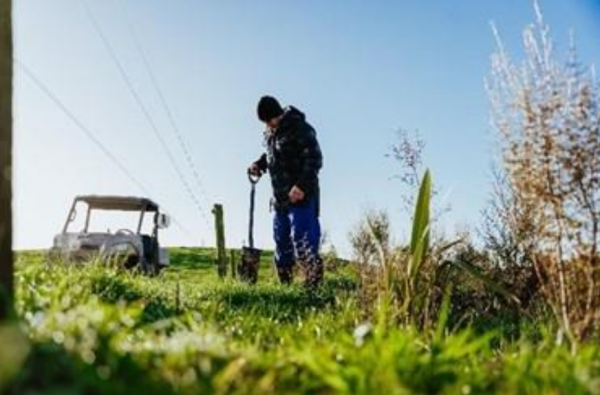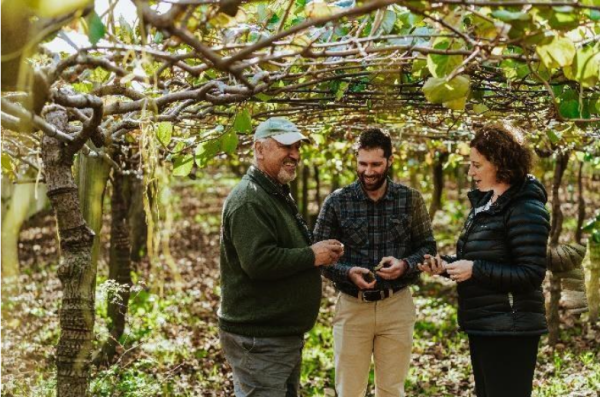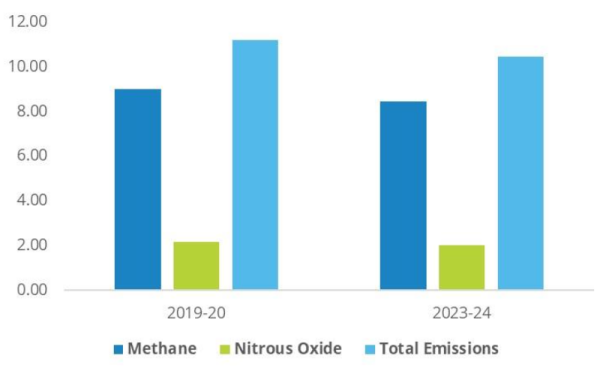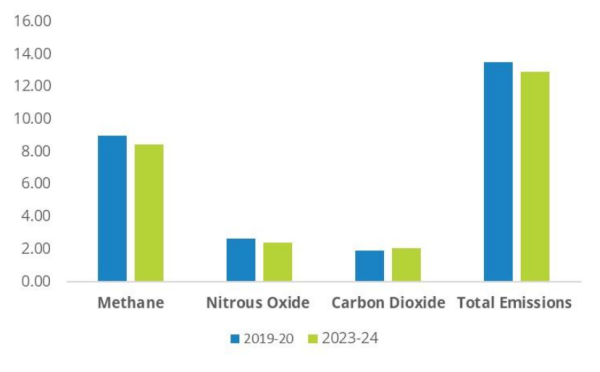Te Arawa Management Limited, Bay of Plenty
Te Arawa Management Limited is located in Maketū in the Bay of Plenty. The Arawa tribe spans 56 hapū. Te Arawa Lakes Trust (TALT) is the parent entity of the asset holding arm, Te Arawa Management Limited (Te Arawa). Te Arawa operates two dairy farms and six kiwifruit orchards.
Video
Download this story
Download a copy of the Kirikiri dairy story here [PDF, 387 KB]
Overview
The farms are split into two blocks, Arawa farm and Okurei farm, which are 15 kilometres north-east of Te Puke. Okurei point is a prominent headland that separates Maketū/Ōngātoro Estuary and Little Waihi Estuary. The area has a rich history for mana whenua, including being the traditional landing site of Te Arawa waka more than 800 years ago.
Te Arawa Management Ltd was established in 2006 with the main purpose of supporting the Trust to optimise commercial returns from its resources in line with its values. The proximity of the farms to the moana (sea) aligns with its values of protecting the whenua (land) and ensuring sustenance of the farm to provide for their people.
Today, we are enjoying the returns for what we have invested in the whenua a long time ago.
Geoff Rolleston, Te Arawa Lakes Trust chairman
Maketū has long been regarded as a food bowl by Te Arawa, with easy access to the shoreline and a strong history of māra kai (cultivating food). Today it encompasses dairy farming, fishing, fruit and vegetable production, and food manufacturing.
The Okurei farm spans 215.5 hectares (ha), including a milking platform of about 130 ha.

At peak the farm milks around 430 Friesian Jersey cross cows. Nine hectares of the upper terraces have been converted from dairy to kiwifruit since 2012. The Arawa farm, on the western side of Wilson Road North, milks 550 cows on a 154 effective hectare grazing area.
Te Arawa has a sharemilker on both farms. One has whakapapa (genealogy) to the whenua, which is important for Te Arawa as hunga tiaki (collective guardians) with a common purpose and stewards of the whenua.
Table 1: Te Arawa Management Ltd land areas hectares (ha)
| Enterprise | Land area (ha) |
| Pasture (Okurei) | 141 |
| Pasture (Arawa) | 160 |
| Retired areas | 103 |
| Horticulture | 9 |
| Total | 413 |
What changes have been made?
Te Arawa has adopted a values-driven farming model. As it continues to refine and develop its existing on- farm actions, the team is also thinking about the future. Current examples of on-farm actions include:
- converting areas of dairy land into horticulture
- developing and restoring natural wetlands
- extending riparian areas
- optimising pasture species with increased nitrogen fixation and drought tolerance
- reduced nitrogen fertiliser use, and
- using compost rather than chemical fertiliser in orchards where possible.
Careful attention to farm characteristics and strategic planning has enabled Te Arawa to identify the benefits of shifting to a (partial) once-a-day (OAD) milking regime, a reduction in nitrogen fertiliser use, the inclusion of diverse pasture mixes such as plantain, chicory and clovers, and retirement of unsuitable or environmentally sensitive land.

One of the motivators for the system diversification was to explore a farming system with less
environmental impact. Te Arawa began diversifying the Okurei dairy farm into kiwifruit with 3 ha
converted in 2012 and a further 6 ha converted in 2020. Further areas of kiwifruit conversion are
proposed on land the furthest distance from the milking shed. This would support animal welfare by reducing walking distances for milking cows.
Table 2: Arawa block physical parameters
|
Physical parameters |
2020 |
2024 |
|
Effective ha |
172.0 | 165.1 |
| Peak cows | 593 | 520 |
|
Production milk solids/cow |
283 | 308 |
| Summer crop | 0.0 | 4.0 |
|
Total restrictive stock units (RSU) |
5112 | 4697 |
Why were the changes made?
Te Taiao (the environment) is extremely important for Te Arawa. It was conscious of the environmental impact of its dairy operation. This, combined with understanding of the whenua and how to best use the land, motivated the changes.
In recent years, Te Arawa has undertaken a significant amount of diversification, mainly in response to environmental or market changes. For the Trust, continued diversification of the whenua is important for financial and environmental sustainability, and to create a legacy for future mokopuna.
As hunga tiaki and stewards of the land, Te Arawa understands that the time taken to achieve change is much longer than short-term dairy or kiwifruit cycles, or a 10-year business plan. The entity is conducting business through this lens of achieving change over time, and therefore ensuring nutrients in the soil rejuvenate year on year.
GHG modelling method
The farm was modelled in OverseerFM.
What have been the impacts of the changes?
Both farms achieved greenhouse gas reductions in 2020 as a result of less dry matter intake, and also decreased nitrogen fertiliser usage and urinary nitrogen levels. In addition, nitrogen leaching has decreased on both blocks, and cows were wintered off at Arawa to reduce winter stocking rates.
Often landowners see greenhouse gases as a new form of regulation. For us, it’s a new measure. When we look at the holistic system and the values we hold, reducing emissions aligns with our philosophy
Cassandra Crowley, chief executive of Te Arawa Management Ltd
Figure 1: Total biological emissions (methane and nitrous oxide) across the Arawa block on a per ha/yr basis (t CO2e/ha)

Figure 1 above, shows a 7% reduction in total biological emissions from 2019/20 to 2023/24. Figure 2 compares the breakdown of greenhouse gas emissions.
Figure 2: Total greenhouse gas emissions (t CO2e/ha) from TAML’s Arawa block in 2019/20 compared to what is projected in 2023/24.

As shown in the table below, the main agricultural greenhouse gas for the Arawa farm is methane. From 2020 to 2023, methane and nitrous oxide emissions reduced by 4% on the Arawa farm. These reductions were the result of the farm system changes such as retirement of less productive land, reducing cow numbers, increasing milk production per cow, strategic use of low protein feeds to reduce urinary nitrogen, and a reduction in nitrogen fertiliser use.
What process did they go through to make the changes?
Te Arawa worked with advisers to undertake a land use analysis from an environmental and financial perspective. It was identified that some land was not suitable for pastoral grazing and may be better suited to be retired or a wetland. The Bay of Plenty Regional Council agreed to partner with Te Arawa in an environmental programme to extend riparian areas and restore approximately 4 ha of low-lying land on Arawa farm to its natural wetland state.
The restoration led to significant environmental benefits for the wai (water), and the whenua, but also revitalisation of threatened species such as tuna (eel) coming back into the area.
The land use analysis also identified that horticulture, to a certain extent, would provide a higher income stream and better environmental footprint for Te Arawa. The Board backed the environmentally and financially viable conversion.
What other changes are planned?
Te Arawa is proactive in its approach to the environment. Currently it is planning to invest in
improved infrastructure such as a new effluent system, which will further reduce the nutrient loss for the farm system.
What drives or constrains these changes?
Farmers are encouraged to have a written plan in place to reduce their biological greenhouse gas
emissions in future. Te Arawa uses Overseer FM to forecast greenhouse gas emissions, nitrate leaching and to ensure all farm nutrients are utilised as efficiently as possible. “As part of our environmental stewardship, we are actively trying to learn and improve, and to know our greenhouse gas number is important,” says Josh MacDonald (Ngāti Mākino), sharemilker at the Arawa farm.
Table 3: TAML Arawa Block emissions from OverseerFM
|
Arawa farm |
2020 |
2024 | % Change |
|
Total area (ha) |
177.5 | 164.5 | |
|
Total Methane (t CO2e/ha/yr) |
9.00 | 8.45 | -6% |
|
Total Nitrous oxide (t CO2e/ha/yr) |
2.63 | 2.43 | -8% |
|
Total CO2e (t/ha) |
1.9 | 2.08 | 9% |
|
Total GHG (t CO2e/ha/yr) |
13.53 | 12.96 | -4% |
|
Biological Methane (t CO2e/ha/yr) |
9.00 | 8.43 | -6% |
|
Biological Nitrous oxide (t CO2e/ha/yr) |
2.18 | 2.00 | -8% |
|
Total biological GHGs (t CO2e/ha/yr) |
11.18 | 10.44 | -7% |
|
Total Methane (kg CH4/ha) |
360 | 337 | -6% |
|
Nitrogen leached (kg N/ha/yr) |
33.4 | 26.4 | -21% |
What advice do they have for other farmers?
“No one has a perfect solution, and you don’t have to be perfect. You can start by introducing a new grass species or doing some riparian planting,” says Cassandra. “The whānau at Te Arawa said its advice to other farmers and growers is that it is important you don’t let perfectionism get in the way of progress.”
Published: July 22, 2025

